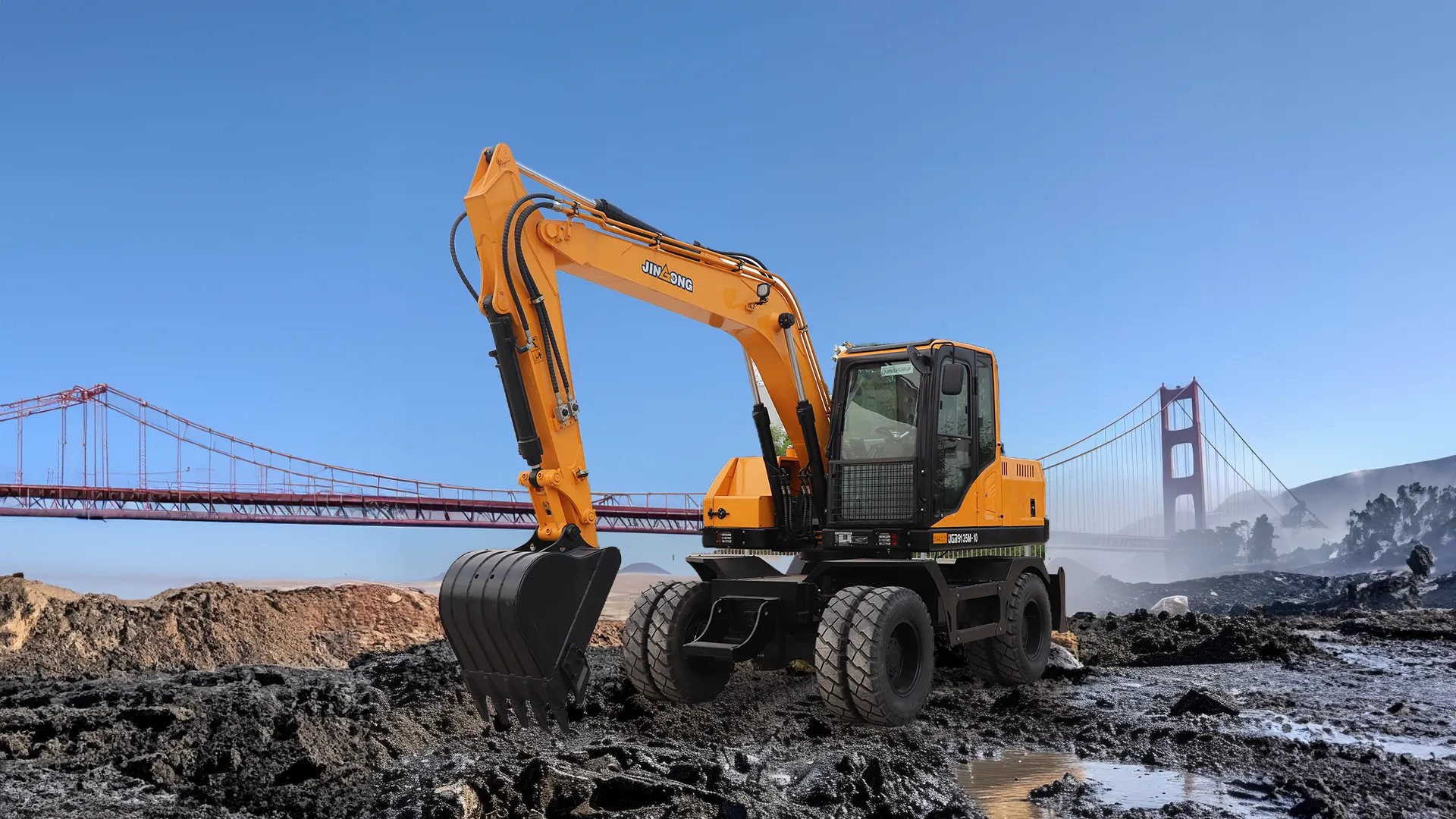Understanding the Hydraulic System in Excavators: An In-Depth Look
Understanding the Hydraulic System in Excavators: An In-Depth Look
Table of Contents
What is a Hydraulic System in Excavators?
The Importance of Hydraulic Systems in Excavators
Main Components of Hydraulic Systems in Excavators
How Hydraulic Systems Work in Excavators
Types of Hydraulic Systems Used in Excavators
Hydraulic System Maintenance for Excavators
Troubleshoot
Jul 09,2025

Understanding the Hydraulic System in Excavators: An In-Depth Look
Table of Contents
- What is a Hydraulic System in Excavators?
- The Importance of Hydraulic Systems in Excavators
- Main Components of Hydraulic Systems in Excavators
- How Hydraulic Systems Work in Excavators
- Types of Hydraulic Systems Used in Excavators
- Hydraulic System Maintenance for Excavators
- Troubleshooting Common Hydraulic System Issues in Excavators
- The Future of Hydraulic Systems in Excavators
- FAQs About Hydraulic Systems in Excavators
What is a Hydraulic System in Excavators?
The hydraulic system in excavators is a vital mechanism that allows these powerful machines to perform various tasks with great precision and efficiency. Essentially, a hydraulic system uses pressurized fluid to transmit energy, which powers the machine's various functions, such as digging, lifting, and rotating. By employing hydraulic principles, excavators can exert significant force while maintaining agility and control, making them indispensable in construction and engineering projects.
The Importance of Hydraulic Systems in Excavators
Hydraulic systems are crucial to excavators for several reasons:
Enhanced Power and Efficiency
Excavators equipped with hydraulic systems can perform tasks that require substantial force, such as breaking hard ground or lifting heavy materials. The efficiency of hydraulic systems allows excavators to operate smoothly, minimizing energy consumption while maximizing output.
Precision and Control
Hydraulic systems enable operators to control movements with remarkable accuracy. This precision is essential for tasks that demand detailed work, such as excavating trenches or placing materials in specific locations.
Versatility
Excavators can be fitted with various attachments, such as buckets, hammers, and grapples, all powered by hydraulic systems. This versatility makes them suitable for a wide range of applications, from construction to demolition and landscaping.
Main Components of Hydraulic Systems in Excavators
Understanding the main components of hydraulic systems is essential for appreciating how they operate:
Hydraulic Pump
The hydraulic pump is the heart of the hydraulic system. It converts mechanical energy into hydraulic energy by pressurizing fluid. The type of pump, whether gear, vane, or piston, directly impacts the system’s efficiency and performance.
Hydraulic Fluid
Hydraulic fluid is the medium through which power is transmitted in the system. This fluid must have the right viscosity and properties to ensure optimal performance and prevent equipment damage.
Control Valves
Control valves regulate the flow and direction of hydraulic fluid, allowing operators to control the movements of the excavator's components. These valves can be manually or electronically operated, depending on the machine's complexity.
Actuators
Actuators are components, such as hydraulic cylinders and motors, that convert hydraulic energy back into mechanical energy. They perform the physical actions required for digging, lifting, or rotating.
Filters
Hydraulic filters are essential for maintaining the cleanliness of hydraulic fluid. They remove contaminants that could impair system performance or cause damage to components.
How Hydraulic Systems Work in Excavators
The operation of hydraulic systems in excavators is based on Pascal's principle, which states that pressure applied to a confined fluid is transmitted undiminished throughout the fluid. Here's a step-by-step breakdown of how hydraulic systems work:
Fluid Pressurization
When the operator activates a control, the hydraulic pump draws fluid from the reservoir and pressurizes it. This high-pressure fluid is then directed through hoses to the appropriate components, such as hydraulic cylinders.
Actuation and Movement
As the pressurized fluid enters a hydraulic cylinder, it forces the piston within the cylinder to move. This movement translates into linear motion, allowing the excavator’s arm or bucket to lift, lower, or extend.
Control and Feedback
The control valves enable operators to determine the flow and direction of the hydraulic fluid. By manipulating these valves, operators can achieve smooth and precise movements of the excavator, responding rapidly to changes in operational demands.
Types of Hydraulic Systems Used in Excavators
Excavators utilize different types of hydraulic systems, each with unique characteristics and applications. The most common types include:
Open-Center Hydraulic Systems
Open-center systems allow fluid to flow continuously through the system, returning to the reservoir when not in use. This design is straightforward and cost-effective, making it suitable for many standard excavators.
Closed-Center Hydraulic Systems
Closed-center systems maintain continuous pressure in the system, allowing for instantaneous response to control inputs. These systems are more efficient and provide better performance in complex machinery, often used in high-end excavators.
Variable Displacement Pumps
Variable displacement pumps adjust their output based on demand, providing the appropriate amount of hydraulic fluid for the task at hand. This adaptability contributes to energy efficiency and better control.
Hydraulic System Maintenance for Excavators
Regular maintenance is crucial for ensuring the longevity and efficiency of hydraulic systems in excavators. Here are some best practices:
Fluid Quality Monitoring
Regularly check the hydraulic fluid for contamination, viscosity, and levels. Clean or replace fluid as necessary to prevent damage to the system.
Component Inspection
Frequent inspections of hydraulic components, including pumps, valves, and cylinders, can help identify wear and tear early. Replace damaged or worn-out parts promptly to maintain system integrity.
Filter Replacement
Filters should be replaced according to the manufacturer’s recommendations. Clogged filters can restrict fluid flow and reduce system efficiency.
Leak Detection
Check for leaks in hoses, fittings, and cylinders. Addressing leaks immediately can prevent fluid loss and damage to the hydraulic system.
Troubleshooting Common Hydraulic System Issues in Excavators
Despite proper maintenance, hydraulic systems can encounter issues. Here are common problems and their solutions:
Loss of Power
Symptoms may include sluggish movements or inability to lift loads. Check for low fluid levels, leaks, or clogged filters.
Unresponsive Controls
If the controls do not respond, inspect the control valves for proper operation and ensure there are no blockages or fluid restrictions.
Noisy Operation
Excessive noise may indicate air in the hydraulic fluid or worn components. Bleeding the system or replacing worn parts can often resolve this issue.
Overheating
An overheating hydraulic system can lead to fluid degradation. Check fluid levels, ensure proper cooling, and inspect for any blockages in the cooling system.
The Future of Hydraulic Systems in Excavators
The future of hydraulic systems in excavators is poised for transformation with advancements in technology.
Integration of Smart Technology
Smart technology integration, including sensors and IoT connectivity, is set to enhance operational efficiency. Real-time monitoring can help in predictive maintenance and reduce downtime.
Electric and Hybrid Systems
The shift towards electric and hybrid hydraulic systems promises to increase efficiency and reduce environmental impact. These systems can offer improved power-to-weight ratios and lower emissions while providing the same level of performance.
Advanced Materials and Design
The use of advanced materials in hydraulic components can lead to lighter and more durable solutions. Innovations in design will allow for more compact systems, contributing to the overall effectiveness of excavators.
FAQs About Hydraulic Systems in Excavators
What type of hydraulic fluid should I use in an excavator?
It’s crucial to use hydraulic fluid recommended by the manufacturer, which typically meets specific viscosity and performance standards.
How often should I change the hydraulic fluid?
Hydraulic fluid should be changed as per the equipment’s service manual, usually every 1,000 to 2,000 hours of operation or when it shows signs of contamination.
What are signs of hydraulic fluid contamination?
Signs include discoloration, unusual odors, the presence of particles, or foam in the fluid, indicating a need for immediate replacement.
How can I reduce hydraulic system wear and tear?
Regular maintenance, using proper hydraulic fluid, and monitoring system performance can significantly reduce wear and tear on hydraulic components.
Are closed-center hydraulic systems better than open-center systems?
Closed-center systems offer better efficiency and response, making them suitable for high-performance excavators, while open-center systems are more cost-effective for standard applications.
Conclusion
An in-depth understanding of hydraulic systems in excavators reveals their critical role in modern construction and engineering. By appreciating the mechanics, components, and maintenance practices, operators can enhance performance and extend the lifespan of their equipment. As technology evolves, so too will the potential of hydraulic systems, paving the way for more efficient and environmentally friendly excavators in the future. Embracing these innovations will ensure that excavators remain a cornerstone of construction capabilities for years to come.











